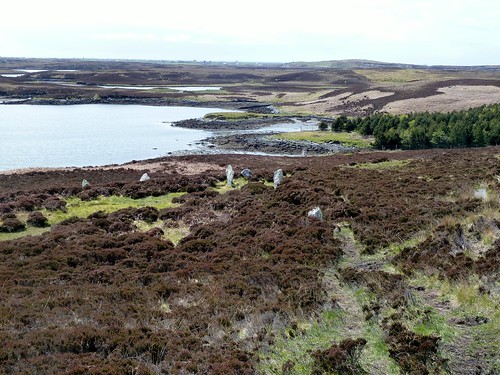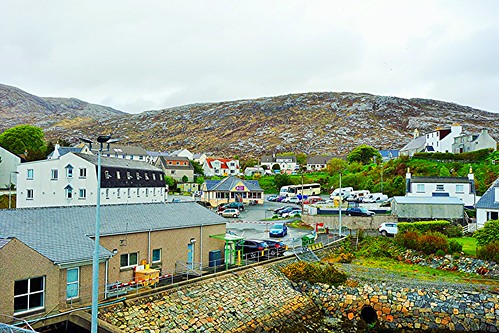Scotland's Western Isles: Mainly Gaelic speaking with extensive history and Harris Tweed manufacture.
(Above image is a capture of a beach/coastal scene.)
The Outer Hebrides or Western Isles consist of a 130 mile long (210 Km.) chain off the west of the Scottish mainland.
The Hebrides stretch between latitudes 57-58 N. There are many uninhabited islands but the ten populated islands are: Lewis (including Great Bernera), Harris, Scalpay, Berneray, North Uist, Benbecula, South Uist, Eriskay, Barra and Vatersay. Access from the mainland is by air or ferry.More Information
These islands have much to offer the visitor including: Prehistory (stone circles and brochs), photography, wildlife, Harris Tweed manufacture, Gaelic culture, golf, clan history and private ancestry research, castles, geology, Viking influences, quaint thatched cottages, peat workings, crofting, glorious sandy beaches, seafood and much more.Barra (Eilean Bharraigh)
Located near the southern tip of the Hebrides island chain, Barra is just 8 miles (13 Km) long and centred around the small town of Castlebay ( Bagh A Chaisteil) which benefits from a large natural harbour which is also the ferry port. In the bay is Kisimul Castle (Clan MacNeil) which is open to the public. Places to visit include: Allt Chrisal archaeological site, Island of Vatersay, Castle St Clair, Standing Stones near Borve, Dun Cuier Iron Age Fort, Seal Bay, Cille Bhara religious site and Barra’s unique Traigh Mhor beach airport. Allow a minimum of one day and one overnight here.
Kisimul Castle
Barra Airport
South Uist (Uibhist a Deas)
Situated north of Barra, South Uist is 21 miles (34 Km.) long with much of the west coast comprising sandy beaches. There is also machair, freshwater lochs, sea lochs and mountains. Lochboisdale (Loch Baghasdail) is the main sea port. Noteworthy places to visit include: 19th C Pollacher Inn; nine hole golf course at Askernish; Cladh Hallan prehistoric village; birthplace of Flora MacDonald at Milton; thatched houses at Howmore (Tobha Mor); and Loch Druidibeg National Nature Reserve which is the breeding ground for the greylag goose.
Cladh
Hallan began around 2200 BC as a settlement and fields. Around 1250 BC
the small U-shaped house form was replaced by a new type of house, the
roundhouse.
Borve Castle
Traditional House
North Uist (Uibhist a Tuath)
Situated north of Benbecula and south of Harris. Main town is Lochmaddy (pop 300). There is also the community at Grimsay which specialises in shell fish.
Pobul Fhin Stone Circle
Lewis (Eilean Leodhais)
Lewis is located at the northern tip of the Hebrides island chain. Here is Stornoway, capital of the Western Isles with both air and sea links to the mainland. Lewis has a significant historic heritage incorporating prehistory (Callanish Stones), the Iron-Age ( Carloway Broch), the Norse era (Shawbost), Blackhouses, the Whalebone Arch and more.
Tip for Visiting
If time permits, allow about one week and commence with ferry from Oban to Barra then move north through the island chain and depart from Stornoway via ferry transfer to Ullapool in the northern Highlands. There are other options including flights to/from Barra or Stornoway.
.
Eriskay (Eiriosgaigh)
This is a small island measuring 1.5 miles by 2.5 miles which lies between Barra and South Uist. Main occupation of the residents is fishing and crofting (farming). This island is famous for: landing place of Bonnie Prince Charlie in 1745; traditional Eriskay ponies; and the wreck of the SS Politician in 1941 carrying 20,000 cases of whisky (‘Whisky Galore’).Benbecula (Beinn na Faoghla)
Benbecula is located between South Uist and North Uist, the name means ‘Mountain of the Fords’. Balivanich is the main community centre. Places to visit include: Dunganachy iron-age fort, site of old monastery at Balivanich, scenic Culla Bay, ruined chapel and nunnery at Nunton, bay at Poll-na-Crann (large seaweed deposits) and Borve Castle.Borve Castle
Traditional House
North Uist (Uibhist a Tuath)
Situated north of Benbecula and south of Harris. Main town is Lochmaddy (pop 300). There is also the community at Grimsay which specialises in shell fish.
- Dun an Sticer– a well preserved iron-age broch.
- Dun Aonghais-on an island in the loch is the Fort of Angus the Fair.
- Dun Scolpaig- a Tower (1830) which replaced an iron-Age fort.
- Kilpheder Cross- Re-erected after discovery in a churchyard.
- Clettravel-a Neolithic chambered cairn and wheelhouse.
- Hougharry-a traditional ‘baile’ or township.
- Teampull na Trionaid- dating from the 12th century.
- Barpa Langass- a Neolithic passage grave.
- Pobull Fhinn-an oval stone circle comprising at least 24 stones.
- Mausoleum of the MacLeans- on island of Boreray.
Landscape
Traditional House
Cutting Peat
Pobul Fhin Stone Circle
South Harris (Ceann A Deas)
Situated north of North Uist, the main town and ferry port is Tarbert (An Tairbeart). A circular tour will provide access to many beautiful beaches and scenic views. Near Horgabost village are large, prehistoric stones known as Coir Fhinn. There are other standing stones at Clach Micleoid on Aird Nisabost. There is also a Genealogy Centre, the McGillivary Ornithology Centre and the 16th C St. Clements Church at Rodel which houses one of the finest tombs in Scotland (Clan Macleaod). Traditional Harris Tweed weaving is still undertaken and visits to weaving businesses can be made.
Harris Tweed Weaver
Tarbert
North Harris (Ceann A Tuath Na Hearadh)
Very mountainous and popular with hill walkers and climbers. Here can be found Clisham (792m), the highest mountain in the Western Isles.
Back Road
Lewis (Eilean Leodhais)
Lewis is located at the northern tip of the Hebrides island chain. Here is Stornoway, capital of the Western Isles with both air and sea links to the mainland. Lewis has a significant historic heritage incorporating prehistory (Callanish Stones), the Iron-Age ( Carloway Broch), the Norse era (Shawbost), Blackhouses, the Whalebone Arch and more.
Callanish Stones
Arnish Lighthouse
Port Stoth, Butt of Lewis
Stornoway
Tip for Visiting
If time permits, allow about one week and commence with ferry from Oban to Barra then move north through the island chain and depart from Stornoway via ferry transfer to Ullapool in the northern Highlands. There are other options including flights to/from Barra or Stornoway.
Ullapool-Hebrides Ferry
.

















Comments
Post a Comment